HMNB Portsmouth
Her Majesty's Naval Base, Portsmouth (HMNB Portsmouth) is one of three operating bases in the United Kingdom for the Royal Navy (the others being HMNB Clyde and HMNB Devonport). Portsmouth Naval Base is part of the city of Portsmouth; it is located on the eastern shore of Portsmouth Harbour, north of the Solent and the Isle of Wight. Until the early 1970s, it was officially known as Portsmouth Royal Dockyard (or HM Dockyard, Portsmouth); thereafter the term 'Naval Base' gained currency, acknowledging a greater focus on personnel and support elements alongside the traditional emphasis on building, repairing and maintaining ships.[3] In 1984 Portsmouth's Royal Dockyard function was downgraded and it was formally renamed the 'Fleet Maintenance and Repair Organisation' (FMRO).[4] The FMRO was privatized in 1998[5] (and for a time (2002-2014) shipbuilding, in the form of block construction, returned).[6] Around the year 2000, the designation HMS Nelson (which until then had been specific to Portsmouth's Naval Barracks in Queen Street) was extended to cover the entire base.
| HMNB Portsmouth | |
|---|---|
Pompey | |
| Portsmouth, Hampshire, England
| |
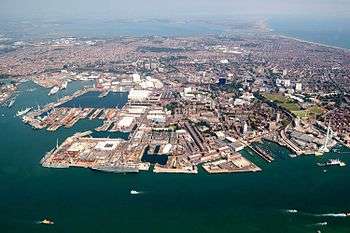 An aerial photograph of Portsmouth Dockyard, viewed from the west, taken as part of a photographic exercise from 2,000 feet. | |
| Type | Military base |
| Site information | |
| Controlled by | Royal Navy |
| Site history | |
| In use | 1194[1]–present |
| Garrison information | |
| Current commander | Commodore Jeremy Bailey [2] |
| Garrison | Surface Flotilla [2] |
The base is the headquarters for two-thirds of the Royal Navy's surface fleet, and employs up to 17,200 people. The base is also home to a number of commercial shore activities (including a ship repair facility operated by BAE Systems Maritime); naval logistics, accommodation and messing; and personnel support functions (e.g. medical and dental; education; pastoral and welfare) provided by Defence Equipment and Support. Portsmouth has built sections for, and will be home port to, the two new Royal Navy aircraft carriers, HMS Queen Elizabeth and HMS Prince of Wales. They required the harbour to be dredged to allow safe entry and exit.[7] The project was intended to secure the base's future for the next forty years and would revitalise shipbuilding in the city;[8] but, due to budget cuts in 2013 shipbuilding in Portsmouth was closed in favour of BAE keeping its yards in Glasgow open. It has been speculated this was to help retain Scotland in the union during the 2014 Scottish independence referendum and it has been suggested by the BAE chairman that shipbuilding could return to the city if Scotland voted for independence.[9]
Portsmouth naval base is the oldest in the Royal Navy, and it has been an important part of the Senior Service's history and the defence of the British Isles for centuries. At one time it was the largest industrial site in the world.[10] It is home to one of the oldest drydocks in the world. The former Block Mills are of international significance, having been the first factory in the world to employ steam-powered machine tools for mass production.[11] In 1985 a partnership between the Ministry of Defence and Portsmouth City Council created the Portsmouth Naval Base Property Trust to manage part of the historic south-west corner of the Naval Base, under a 99-year lease, as a heritage area: Portsmouth Historic Dockyard.[6] It allows members of the public to visit important maritime attractions such as Mary Rose, HMS Victory and HMS Warrior.
Functioning base
Portsmouth naval base is home to two-thirds of the Royal Navy's surface ships, and employs up to 17,200 people.
Senior personnel
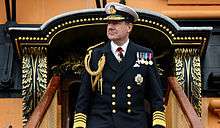
The Naval Base Commander (NBC) since March 2019 Commodore Jeremy Bailey. The harbour is under the control of the Queen's Harbour Master (QHM), working to the Naval Base Commander is currently Commander Steve Hopper, who is the regulatory authority of the Dockyard Port of Portsmouth, an area of approximately 50 square miles (130 km2) that encompasses Portsmouth Harbour and the Eastern Solent. QHM Harbour Control is based in the Semaphore Tower building. Shipping movements are handled by a team of admiralty pilots headed by the Chief Admiralty Pilot, Nick Randall.
In 1836 the Commander-in-Chief, Portsmouth was given accommodation within the Dockyard (in Admiralty House) and in 1889 he was given HMS Victory to be his ceremonial flagship. These privileges were inherited by the Commander-in-Chief Naval Home Command in 1969 and by the Second Sea Lord in 1994. The latter continued (as Commander-in-Chief Naval Home Command) to fly his flag from HMS Victory (the oldest commissioned warship in the world) until 2012. Since then, the post of Commander-in-Chief has reverted to the First Sea Lord, and with it the use of Victory as flagship. The Second Sea Lord is now at Henry Leach Building on Whale Island, which is also the headquarters of the Fleet Commander.
Portsmouth Flotilla
The base plays host to a large part of the surface fleet of the Royal Navy including the Queen Elizabeth-class aircraft carrier, the Type 45 destroyers, six Type 23 frigates, the River-class patrol vessels and a squadron of mine counter-measures vessels, both minesweepers and minehunters. Most of the vessels based in Portsmouth form part of the Portsmouth Flotilla, under the Fleet First reorganisation which saw the three port flotilla, Portsmouth, Devonport and Faslane, replace the frigate and destroyer squadrons and other groupings. The flotilla is a component unit of the Royal Navy Surface Fleet.
Ship of the Line
Queen Elizabeth-class aircraft carriers
Type 45 destroyers
Type 23 frigates
- HMS Kent
- HMS Lancaster
- HMS Iron Duke (Currently in LIFEX refit)
- HMS Westminster
In changes to base porting arrangements announced in November 2017, HM Ships Westminster, Richmond, Kent and St Albans will move to the Devonport Flotilla by 2023; HM Ships HMS Argyll, HMS Monmouth and HMS Montrose will move in the opposite direction. Richmond becomes a Devonport ship on completion of her refit. St Albans moved to Devoport in July 2019 in preparation for her major refit.[12]
Hunt-class mine countermeasures vessels
.jpg)
- HMS Ledbury - on operation in the gulf (preparing to come home)
- HMS Cattistock
- HMS Brocklesby - on operation in the gulf
- HMS Middleton
- HMS Chiddingfold - on operation in the gulf
- HMS Hurworth - in refit
River-class patrol vessels
- HMS Tyne
- HMS Severn
- HMS Mersey
- HMS Forth[13] – currently in the Falklands as guard ship since 2019
- HMS Medway - currently in the Caribbean since 2020
- HMS Trent
- HMS Tamar
Archer-class patrol vessels
The fourteen Archer class (P2000) patrol vessels assigned to the First Patrol Boat Squadron supporting the University Royal Naval Units are formally part of the Portsmouth Flotilla, albeit many are permanently based elsewhere around the United Kingdom.
- HMS Archer – Edinburgh Universities Royal Naval Unit – Based in Leith.
- HMS Biter – Manchester and Salford Universities Royal Naval Unit – Based at HMS Eaglet in Liverpool.
- HMS Blazer – Southampton Universities Royal Naval Unit – Based in Portsmouth.
- HMS Charger – Liverpool Universities Royal Naval Unit – Based at HMS Eaglet in Liverpool.
- HMS Dasher – Based in Gibraltar.
- HMS Example – Northumbrian Universities Royal Naval Unit – Based at HMS Calliope in Gateshead.
- HMS Exploit – Birmingham Universities Royal Naval Unit – Based in Portsmouth.
- HMS Explorer – Yorkshire Universities Royal Naval Unit – Based in Hull.
- HMS Express – Wales Universities Royal Naval Unit – Based in Penarth Marina.
- HMS Puncher – London Universities Royal Naval Unit – Based in Portsmouth.
- HMS Pursuer – Based in Gibraltar.
- HMS Ranger – Sussex Universities Royal Naval Unit – Based in Portsmouth.
- HMS Smiter – Oxford Universities Royal Naval Unit – Based in Portsmouth.
- HMS Trumpeter – Cambridge Universities Royal Naval Unit – Based in Ipswich.
Portsmouth Historic Dockyard
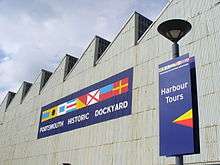
"Portsmouth Historic Dockyard" is the name given to the portion of the base which is open to the public; it plays host to:[14]
- The raised wreck of the Tudor carrack Mary Rose viewable in a new (2013) Mary Rose Museum building.
- HMS Victory, Nelson's flagship at Trafalgar, which (whilst still being in commission) is also open to the public
- HMS Warrior (1860), the first ocean-going Ironclad (built at Blackwall on the River Thames in 1860 and now moored in the dockyard).
- HMS M33, a World War I monitor (opened to the public in 2015)
- The National Museum of the Royal Navy, Portsmouth, one of the world's leading maritime museums. Exhibits include the Trafalgar Sail (the foretop sail of Victory used at the Battle of Trafalgar, 1805)
- Action Stations, a centre containing interactive exhibits demonstrating various aspects of naval science as well as a number of simulators
- The Dockyard Apprentice exhibition, telling the story of the Dockyard itself and working life within it.[15]
- Portsmouth Harbour Tours
- Boathouse 4 (opened 2015), which tells the 'forgotten story' of the small boats of the Navy and is an active boat building and restoration site.
The Royal Marines Museum is due to relocate to the Historic Dockyard from Eastney; it was scheduled to reopen in 2019 in Boathouse 6, but due to a funding shortage this has been delayed, probably until 2022.[16] Following the relocation of a boatbuilding exhibit (to Boathouse 4), Boathouse 5 is being refurbished as a new 'orientation and ticketing facility'.[17]
The Portsmouth Naval Base Property Trust has long sought to extend the area of the Historic Dockyard to cover Dry Docks 4 and 5 and the historic Block Mills building among others. In 2015 an architectural design competition for the project was won by Latz+Partner;[18] however the Ministry of Defence subsequently indicated that property to the north of the Mary Rose will not be ceded for several years at least, due to the site's proximity to the proposed berth of the new Queen Elizabeth-class aircraft carriers.[17]
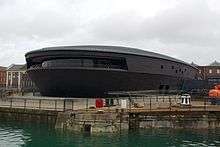 The Mary Rose Museum
The Mary Rose Museum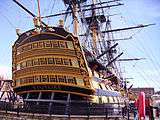 HMS Victory
HMS Victory.jpg) HMS Warrior (1860)
HMS Warrior (1860)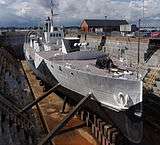 HMS M33
HMS M33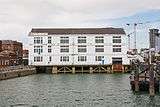 Boathouse No 4 (built in 1939): Boatbuilding skills training centre and 'Forgotten Craft' exhibition
Boathouse No 4 (built in 1939): Boatbuilding skills training centre and 'Forgotten Craft' exhibition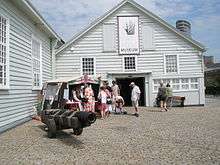 Boathouse No 5 (built as a Mast House and Sail Loft in 1807) formerly housed the Mary Rose Museum
Boathouse No 5 (built as a Mast House and Sail Loft in 1807) formerly housed the Mary Rose Museum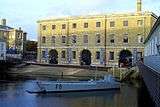 Boathouse No 6 (built 1845-8): Action Stations
Boathouse No 6 (built 1845-8): Action Stations- Boathouse No 7 (built as a Mast House in 1807): The Dockyard Apprentice exhibition, together with café and shops
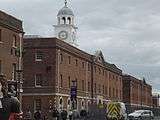 Nos 10 & 11 Storehouses (1776 & 1763) house part of the National Museum of the Royal Navy
Nos 10 & 11 Storehouses (1776 & 1763) house part of the National Museum of the Royal Navy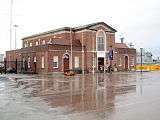 The Victory Gallery: purpose-built in 1938 to display exhibits related to Lord Nelson and HMS Victory
The Victory Gallery: purpose-built in 1938 to display exhibits related to Lord Nelson and HMS Victory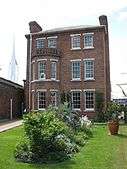 The Porter's Garden is open to the public. (The building once housed the Superintendent of Police but is now offices for the Portsmouth Naval Base Property Trust.)
The Porter's Garden is open to the public. (The building once housed the Superintendent of Police but is now offices for the Portsmouth Naval Base Property Trust.)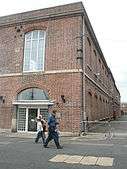 It is planned that Storehouse 12 (1849–53), currently the Royal Naval Museum Library, will accommodate a new 'Centre for Discovery' from 2021.
It is planned that Storehouse 12 (1849–53), currently the Royal Naval Museum Library, will accommodate a new 'Centre for Discovery' from 2021.
History
Along with Woolwich, Deptford, Chatham and Plymouth, Portsmouth has been one of the main Royal Navy Dockyards or Bases throughout its history.
Medieval period
Richard I ordered construction of the first dock on the site in 1194, while his successor John added walls around the area in 1212.[19] The docks were used by various kings when embarking on invasions of France through the 13th and 14th centuries, including the Saintonge War in 1242. Edward II ordered all ports on the south coast to assemble their largest vessels at Portsmouth to carry soldiers and horses to the Duchy of Aquitaine in 1324 to strengthen defences.
Tudors
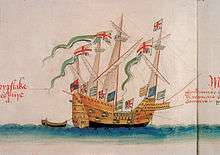
The first recorded dry dock in the world was built in Portsmouth by Henry VII in 1495. The first warship built here was the Sweepstake of 1497; of more significance were the carracks Mary Rose of 1509 and Peter Pomegranate of 1510—both were rebuilt here in 1536. The wreck of the Mary Rose (which capsized in 1545, but was raised in 1982), is on display in a purpose built museum. A fourth Tudor warship was the galleass Jennett, built in 1539 and enlarged as a galleon in 1558.
The appointment of one Thomas Jermyn as Keeper of the Dock at Portsmouth is recorded in 1526, with a Clerk of the Stores being appointed from 1542.[20] Contemporary records suggest that the dry dock was enlarged and rebuilt in 1523 in order to accommodate the Henry Grace à Dieu (the largest ship of the fleet at that time); but a hundred years later it is described as being filled with rubble.[21]
Following the establishment of Chatham Dockyard in the mid-1500s, no new naval vessels were built here until 1648, but ships from Portsmouth were a key part of the fleet that drove off the Spanish Armada in 1588. There are no on-site remains of the Tudor Dock and Yard.
Seventeenth century
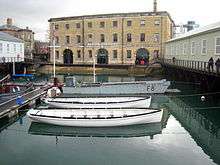
Naval shipbuilding at Portsmouth recommenced under the English Commonwealth, the first ship being the eponymous Fourth-rate frigate Portsmouth launched in 1650. (Portsmouth had been a parliamentarian town during the civil war). A resident Commissioner was first appointed in 1649 (fifteen years later the Commissioner was provided with a house, and extensive gardens, at the centre of the yard).[23] A new double dry dock (i.e. double the standard length so as to accommodate two ships at once) was built by the Commonwealth government in 1656, on what was then the tip of land at the north-west corner of the yard. It was joined by a single dry dock, just to the south; the yard's one shipbuilding slip (completed in 1651) stood between the two docks. These would all have been built of timber, rather than stone.[23]
By 1660 the dockyard had, in addition to these large-scale facilities for shipbuilding and repairs, a new ropery (1,095 ft in length) and a variety of small storehouses, workshops and dwellings arranged around the site, which was now enclosed by a wooden palisade. After the Restoration, there was continued investment in the site with the building of a new mast pond and mast house in the 1660s.
Dummer's pioneering engineering works
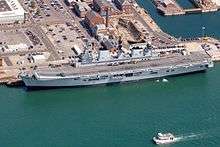
As France began to pose more of a military threat to England, the strategic importance of Portsmouth grew. In 1689, Parliament ordered a new dry dock to be built there, large enough to accommodate the latest first-rate and second-rate ships of the line (which were too big for the existing docks). Work began in 1691; as with all subsequent extensions to the dockyard, the new works were built on reclaimed land (on what had been mud flats, to north of the old double dock) and the civil engineering involved was on an unprecedented scale.
The work was entrusted to Edmund Dummer, naval engineer and surveyor to the Navy Board. His new dry dock (the "Great Stone Dock" as it was called) was built to a pioneering new design, using brick and stone rather than wood and with an increased number of 'altars' or steps (the stepped sides allowed shorter timbers to be used for shoring and made it much easier for shipwrights to reach the underside of vessels needing repair). Extensively rebuilt in 1769, the Great Stone Dock is now known as No.5 dock.[24]
Along with the new dock, Dummer proposed that two wet docks (non-tidal basins) be built: the first ("Lower") Wet Dock was entered directly from the harbour and provided access to the Great Stone Dock; since much expanded, it remains in place (now known as "No. 1 Basin"). The second ("Upper") Wet Dock was entered by way of a channel. To empty the dry dock, Dummer designed a unique system which used water from the Upper Wet Dock to drive a water-wheel on the ebb tide, which in turn powered a set of pumps. (At high tide, an auxiliary set of pumps was used, powered by a horse gin.)[3]
In 1699 Dummer adapted the channel leading to the Upper Wet Dock, enabling it to be closed off at each end by a set of gates, thus forming a second dry dock (called the "North Stone Dock" after it was rebuilt with stone altars in 1737, and known today as No 6 dock). Severed from the harbour, the Upper Wet Dock became a reservoir into which water from various nearby dry docks could be drained; it was vaulted and covered over at the end of the eighteenth century, but still exists today underground.[3] By 1700 a shipbuilding slip had been constructed off the (Lower) Wet Dock, parallel with the dry dock (roughly where No 4 dry dock is today).[25]
Eighteenth century
Between 1704–1712 a brick wall was built around the Dockyard, following the line of the town's 17th-century fortifications; together with a contemporary (though altered) gate and lodge, much of the wall still stands, serving its original purpose.[26] A terrace of houses for the senior officers of the yard was built at around this time (Long Row, 1715–19);[27] later in the century it was joined by a further terrace (Short Row, 1787).[28] In 1733 a Royal Naval Academy for officer cadets was established within the Dockyard, the Navy's first shore-based training facility and a forerunner of Britannia Royal Naval College in Dartmouth.[29]
The 'Great Rebuilding'
The second half of the eighteenth century was a key period in the development of Portsmouth (and indeed of the other Royal Dockyards). A substantial planned programme of expansion and modernisation was undertaken from 1761 onwards, driven (as would be future periods of expansion) by increases both in the size of individual ships and in the overall size of the fleet. In the 1760s the Lower Wet Dock (by then known as the Great Basin) was deepened, the Great Stone Dock was rebuilt and a new dry dock (known today as No 4 dock) was built alongside it over a five-year period from 1767. During 1771-76 the former Upper Wet Dock was reconfigured to serve as a reservoir into which water from the dry docks could be drained by way of culverts (enabling ships to be dry docked much more speedily). From 1789 work was begun on replacing the old wooden South Dock with a modern stone dry dock (known today as No 1 dock, it currently accommodates the museum ship HMS M33).
North of the reservoir a channel was dug leading to a new boat basin, beyond which several shipbuilding slips were constructed on reclaimed land at what became known as the North Corner of the dockyard.[6] The rest of the reclaimed land was given over to storage space for timber with saw pits and seasoning sheds alongside, as shown in the dockyard model of 1774.[30] The open ground between the Basin and the officers' terrace was likewise used to store timber.
Several of Portsmouth Dockyard's most notable historic buildings date from this period, with several older wooden structures being replaced in brick on a larger scale. The three great storehouses (Nos 9, 10 & 11)[31][32][33] were built between 1764 and 1785 on a wharf, alongside a deep canal (or camber) which allowed transport and merchant vessels to moor and load or unload goods; the camber was rebuilt in Portland stone between 1773 and 1785.[23] On the other side of the camber, on newly reclaimed land, two more sizeable brick storehouses were built to serve as a sail loft and a rigging store; the reclaimed land was later named Watering Island after a fresh water supply was provided for ships mooring alongside.[3]
The Double Ropery, over 1,000 ft in length dates from the same period; it is, however, the sixth ropehouse (since 1665) to have stood on the site. Both its immediate predecessors were destroyed by fire (in 1760 and 1770) and the current building was itself gutted by fire in 1776 as the result of an arson attack.[34] It is called a 'double' ropery because the spinning and laying stages take place in the same building (on different floors) rather than on two separate sites. Other buildings associated with ropemaking (including hemp houses, a hatchelling house, tarring house and storehouses) were laid out alongside and parallel to the ropehouse; they largely date from the same period.[6]
Later, in 1784, a large new house was built for the Dockyard Commissioner.[35] Unusually for the time it was designed by a civilian architect (Samuel Wyatt, with Thomas Telford as clerk-of-works); most other dockyard buildings were designed in-house. The dockyard chapel, built eighty years earlier, was demolished to make way for the new Commissioner's house and a new chapel was built nearby.[36] After the old Commissioner's House had been demolished, four identical quadrangular buildings were built, flanking the timber ground east of the Basin; as well as providing storage space, they accommodated workshops for a variety of trades, including joiners, wheelwrights, wood-carvers, capstan-makers and various other craftsmen.[37] At the same time a set of offices for the senior officers of the yard was built overlooking the docks and basin; it continues to provide office space to this day.[38]
 Porters' Lodge (1708), the oldest surviving building in the Dockyard.
Porters' Lodge (1708), the oldest surviving building in the Dockyard.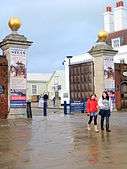 Main Gate (1711, widened c.1940 and now known as Victory Gate).
Main Gate (1711, widened c.1940 and now known as Victory Gate)..jpg) 1711 plaque on the perimeter wall.
1711 plaque on the perimeter wall.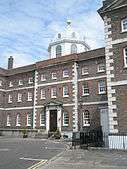 Royal Naval Academy building (1732); it later accommodated the RN Navigation School (HMS Dryad) until 1941.
Royal Naval Academy building (1732); it later accommodated the RN Navigation School (HMS Dryad) until 1941. No 9 Storehouse (1782) – one of a set of three with Nos 10 & 11.
No 9 Storehouse (1782) – one of a set of three with Nos 10 & 11.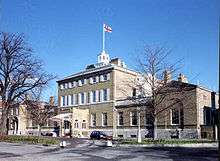 Admiralty House, built as the Commissioner's House in 1784.
Admiralty House, built as the Commissioner's House in 1784.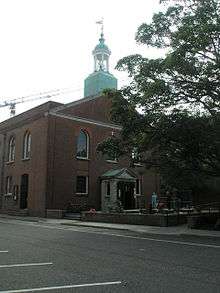 St Ann's Church, HMNB Portsmouth(1787, rebuilt 1956 after bomb damage).
St Ann's Church, HMNB Portsmouth(1787, rebuilt 1956 after bomb damage).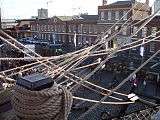 South Office Block (1786–9).
South Office Block (1786–9).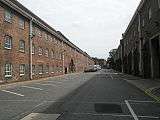 Double Ropery (left, 1771-5) and associated storehouses (right, 1771–81). Between them is Anchor Lane, where anchors were formerly stored in the open air until required.
Double Ropery (left, 1771-5) and associated storehouses (right, 1771–81). Between them is Anchor Lane, where anchors were formerly stored in the open air until required.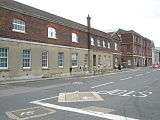 Former Smithery (left, 1791-4); Stores & Workshops (right, 1782; one of four identical blocks).
Former Smithery (left, 1791-4); Stores & Workshops (right, 1782; one of four identical blocks).
Samuel Bentham and industrial revolution
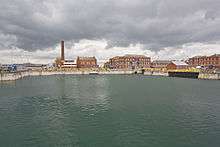
In 1796 Samuel Bentham was appointed Inspector General of Naval Works by the Admiralty with the brief of modernising the Royal Dockyards. As such, he took on responsibility for overseeing the continued rebuilding at Portsmouth and initiated further key engineering works. A prolific inventor and precision engineer, Bentham's initiatives at Portsmouth ranged from instituting new management principles in the manufacturing departments to developing the first successful steam-powered bucket dredger, which began work in the harbour in 1802.[23] His other projects included the following:
The 1761 rebuilding plan had envisaged the old wooden double dock being refurbished, but Bentham instead proposed expanding the Basin (building over the double dock in the process) and adding a further pair of single docks built entirely of stone (unlike previous 'stone docks' which had had timber floors). The proposal was accepted; the new docks (now known as Nos 2 and 3 docks) were completed in 1802-3 and are still in place today (accommodating HMS Victory and the Mary Rose respectively).[39] While constructing a new entrance to the Basin, Bentham introduced the innovation of an inverted masonry arch to tie together the walls on either side. He went on to use the same principle in constructing the new dry docks attached to the basin; it soon became standard for dock construction around the world. In constructing the docks and basin he made pioneering use of Smeaton's waterproof cement. He also designed a "ship caisson" to close off the entrance to the basin (another innovation which soon became a standard design).
To deal with the increasing number of docks, Bentham in 1797 proposed replacing one of the horse pumps above the reservoir with a steam engine. His plan was that the engine should be used not only to drain the reservoir (by night) but also to drive a sawmill and woodworking machinery (during the day); he also envisaged linking it to a freshwater well, to enable water to be pumped through a network of pipes to various parts of the dockyard. A table engine, designed by Bentham's staff chemist James Sadler, was installed in 1799; it represented the first use of steam power in a Royal Naval Yard. By 1800 a second steam engine (a Boulton & Watt beam engine) was being installed alongside the first. Meanwhile, Bentham designed and built a series of subterranean vaulted chambers over the reservoir, upon which he erected a pair of parallel three-storey workshops to contain reciprocating and circular saws, planning machines and morticing machines, built to his own designs, to be driven by the two engines (which were accommodated together with their boilers in the south workshop). Tanks installed on the upper floor provided a head of water for Bentham's aforementioned dockyard-wide pipe network, providing both salt water for firefighting and fresh water for various uses (including, for the first time, provision of drinking water to ships on the wharves) sourced from a newly sunk 274 ft well.[23]
Between the two Wood Mills buildings a single-storey workshop was built in 1802 to accommodate what soon came to be recognised as the world's first steam-powered factory for mass production: Portsmouth Block Mills.[11] Marc Brunel, father of Isambard Kingdom Brunel, famously designed the machines, which manufactured ships' pulley blocks through a total of fifteen separate stages of production. Having been presented with Brunel's designs, which would be built by Henry Maudslay, Bentham incorporated them into his woodworking complex and linked them to the engines by way of line shafts.[40]
At the same time as building his Wood Mills, Bentham, with his deputy Simon Goodrich, was constructing a Metal Mills complex a little to the north-east. Alongside a smithery were a copper-smelting furnace and refinery, and a steam engine which drove a rolling mill and tilt hammers. These facilities were for recycling the copper sheathing of ships' hulls; additional facilities for iron work were soon added and a millwrights' shop was established nearby. The Wood Mills, Block Mills, Metal Mills and Millwrights' department were all placed under Goodrich's supervision as Mechanist to the Royal Navy.
Nineteenth century
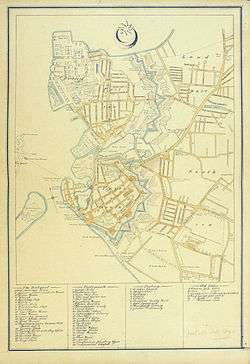
In 1800, the Royal Navy had 684 ships and the Dockyard was the largest industrial complex in the world. In 1805 Horatio Nelson toured the newly opened block mills before embarking from Portsmouth on HMS Victory, leaving Britain for the last time before his death at the Battle of Trafalgar.[40] From 1814 wooden covers were built over the slips and some of the docks to designs by Robert Seppings.
From 1815 the system of Dockyard apprenticeship was supplemented by the establishment of a School of Naval Architecture in Portsmouth (for training potential Master Shipwrights), initially housed in the building which faces Admiralty House on South Terrace.[41] Taking on students from the age of 14, this was the forerunner of Portsmouth Dockyard School (later Technical College) which continued to provide specialist training until 1970.[42]
Victorian and Edwardian dockyard expansion
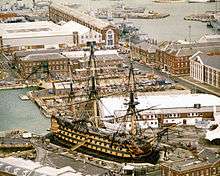
The adoption of steam propulsion for warships led to large-scale changes in the Royal Dockyards, which had been built in the age of sail. The Navy's first 'steam factory' was built at Woolwich in 1839; but it soon became clear that the site was far too small to cope with this revolutionary change in ship building and maintenance. Therefore, in 1843, work began in Portsmouth on further reclamation of land to the north of the then Dockyard to create a new 7-acre basin (known today as No 2 Basin) with a sizeable factory alongside for manufacturing marine steam engines. The Steam Factory, on the western edge of the basin, housed a series of workshops: for construction and repair of boilers, for punching and shearing and for heavy turning; there was also an erecting shop for assembling the finished engines.[43] The upper floor housed pattern shops, fitting shops and other light engineering workshops. Line shafts throughout were powered by an 80hp steam engine accommodated to the rear. New Brass and Iron Foundries were also built soon afterwards, on the southern edge of the basin,[44][45] and in 1852 the Great Steam Smithery was opened alongside the Steam Factory (where Bentham's Metal Mills had formerly stood), containing a pair of steam hammers designed by James Nasmyth.[46] Three new dry docks were constructed over the next 20 years, opening off the new basin, and another was built on reclaimed land west of the basin alongside the shipbuilding slips, which were now five in number (Slips 3-5 were covered by interlinking metal roofs, believed to have comprised the widest iron span in Britain when built in 1845).[6] Meanwhile, facilities for building wooden hulls continued to be updated with a large sawmill having been built behind the slips in 1843.
It transpired, however, that developments in shipbuilding technology led to several of the new amenities having to be rebuilt and expanded almost as soon as they were finished.[3]
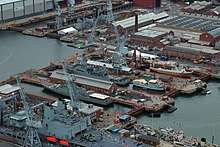
Technological change affected not only ships' means of propulsion, but the materials from which they were built. By 1860 wooden warships, vulnerable as they were to modern armaments, had been rendered largely obsolescent. The changeover to metal hulls not only required new building techniques, but also heralded a dramatic and ongoing increase in the potential size of new vessels. The Dockyards found themselves having to expand in kind. At Portsmouth, plans were drawn up in the late 1850s for further land reclamation north and east of the new Steam Basin, and from 1867 work was begun on a complex of three new interconnected basins, each of 14–22 acres. Each basin served a different purpose: ships would proceed from the repairing basin, to the rigging basin, to the fitting-out basin, and exit from there into a new tidal basin, ready to take on fuel alongside the sizeable coaling wharf there. Three dry docks were also constructed as part of the plan, as well as parallel pair of sizeable locks for entry into the basin complex; the contemporary pumping station which stands nearby not only served to drain these docks and locks, but also delivered compressed air to power cranes, caissons and capstans.[47] This "Great Extension" of Portsmouth Dockyard was largely completed by 1881.[3]
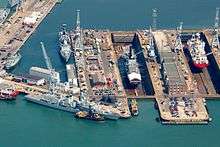
Before the end of the century, however, it was recognised that there would have to be still further expansion across all the Royal Dockyards in order to keep pace with the increasing likely size of future naval vessels. At Portsmouth two more dry docks, Nos 14 & 15, were built alongside the Repairing Basin in 1896; within ten years these, together with the adjacent docks 12 & 13, had to be extended, and by the start of World War I Dock No 14 was over 720 ft in length. The largest Naval ships were now too large for the interlocking basins, so to guarantee access to the new dry docks the intervening walls between the basins were removed to create a single large non-tidal body of water (No 3 Basin), with a pair of 850 ft entrance locks being built at the same time. These (C & D locks) were operational from 1914, and they, together with the enlarged basin and docks, have remained in use, largely unaltered, ever since.[3]
Alongside the new Basins new buildings were erected, on a huge scale, to accommodate new manufacturing and construction processes. These included a gun-mounting workshop (1881, producing gun turrets), torpedo workshop (1886), and the very large New Factory of 1905, to the east of No 13 dock, which was soon put to the task of fitting out Dreadnoughts. Electrification came to the Yard with the opening of a 9,800 kW power station in 1906.
The dockyard railway
.jpg)
In 1843 construction began on a railway system within the dockyard. In 1846 this was connected to Portsmouth Town railway station via what became known as the Admiralty Line. By 1952 there was over 27 miles of track within the dockyard.[48] Its use declined in the 1970s: the link to the mainline was closed in 1977 and locomotives ceased operating within the yard the following year.[6]
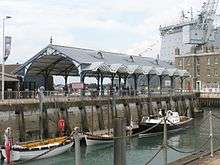
In 1876 a railway station was built on what became known as South Railway Jetty on Watering Island (west of the Semaphore Tower).[49] It was served by a separate branch line which crossed the South Camber by way of a swing bridge and continued on a viaduct over the foreshore, joining the main line just east of Portsmouth Harbour railway station. A small railway station and ornamental cast-iron shelter served in particular the needs of Queen Victoria and her family, who would often transfer from yacht to train at this location; this line soon became the main arrival/departure route for personnel.[50] The swing bridge and viaduct were damaged in the wartime blitz and subsequently dismantled in 1946. The Royal Naval Railway Shelter has recently been moved to the other side of the island and restored.[6]
Twentieth century
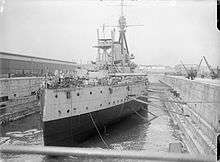
In 1900 the Third class cruiser HMS Pandora was launched, followed by the armoured cruisers Kent in 1901 and Suffolk in 1903. Two battleships of the pre-Dreadnought King Edward VII Class were launched in 1904—Britannia and New Zealand. The first modern battleship, Dreadnought, was built in 1905–06, taking one day more than a year. Further dreadnoughts followed—Bellerophon in 1907, St. Vincent in 1908, Orion in 1910, King George V in 1911, Iron Duke in 1912 and Queen Elizabeth in 1913.
On 8 April 1913, Portsmouth Dockyard opened the first of two new large 850 ft long drydock locks directly connecting Portsmouth Harbour to No.3 Basin, the first named 'C' Lock. A year later, 'D' Lock was opened in April 1914.[51]
First World War
The largest vessel launched at Portsmouth during World War I was the 27,500-ton battleship Royal Sovereign in 1915. The only other launchings during the war were the submarines J1 and J2 in 1915, and K1, K2 and K5 in 1916. Some 1,200 vessels, however, underwent a refit at Portsmouth during the course of the War, and over the same period 1,658 ships were either hauled up the slipways or placed in dry-dock for repairs.[52]
Inter-war years
.jpg)
The period after the war was inevitably a time of contraction at the Dockyard, and there were many redundancies. In accordance with the Government's Ten Year Rule the Dockyard worked over the next decade and a half with a presumption of enduring peace rather than future conflict.[54]
The majority of warships launched at Portsmouth following the end of the War were cruisers—Effingham in 1921, Suffolk in 1926, London in 1927, Dorsetshire in 1929, Neptune in 1933, and Amphion and Aurora in 1934. There were also four destroyers—Comet and her sister Crusader in 1931, and the flotilla leaders Duncan in 1932 and Exmouth in 1934. The only other vessels launched between the wars were the mining tenders Nightingale in 1931 and Skylark in 1932.
New Dockyard facilities included a Steel Foundry, built in 1926. The "Semaphore Tower" was opened in 1930, a facsimile of its namesake (1810–24) which had been destroyed in a fire in 1913. The arch beneath incorporates the Lion Gate, once part of the 18th-century fortifications.[55] The original Semaphore Tower nestled between a sizeable pair of buildings: the Rigging Store and Sail Loft (both of 1784) which perished in the same fire; in the end only one of the pair was rebuilt, as a five-storey office block.[6]
Second World War
The destroyer flotillas (the capital ships having been evacuated to Scapa Flow), were essential to the defence of the English Channel, particularly during Operation Dynamo (the Dunkirk evacuation) and against any potential German Invasion. The base itself served a major refit and repair role. The Germans realised this importance and the city and base in particular was heavily bombed.
Portsmouth and the Naval Base itself were the headquarters and main departure point for the military and naval units destined for Sword Beach on the Normandy coast as a part of Operation Overlord and the D-Day landings on 6 June 1944. Troops destined for each of the landing beaches left from Portsmouth aboard vessels such as the armed merchant cruisers HMCS Prince Henry and HMCS Prince David, escorted by the Canadian destroyers HMCS Algonquin and Sioux. The majority of the naval support for the operation left from Portsmouth, including the Mulberry Harbours. Boathouse 4 (built around the start of hostilities) contributed to the construction of landing craft and support vessels as well as more specialised craft such as midget submarines.[6]
Post Second World War
_MOD_45139767.jpg)
_(IWM).jpg)
There was much rebuilding, demolition and consolidation of bomb-damaged buildings in the aftermath of the Second World War.
In June 1981 the government announced that shipbuilding would cease at Portsmouth, that the workforce would be reduced from just under 7,000 to 1,225 and that the erstwhile Royal Dockyard would become a Fleet Maintenance & Repair Organisation (FMRO) with a minor support and repair role (Devonport and Rosyth would take over major refits and ship modernisation work).[23] The run-down of the Dockyard was put on hold, however, at the start of the Falklands Conflict, with all available hands being put to the task of preparing the Falklands Task Force.
Falklands Task Force
In 1982 Argentina invaded the Falkland Islands. In response a task force of British military and merchant ships was dispatched from Portsmouth Naval Base to the islands in the South Atlantic to reclaim them for the United Kingdom.
The task force consisted of the following ships:
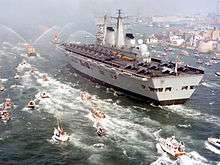
- Two aircraft carriers
- Two landing ship docks
- Eight destroyers
- Fifteen frigates
- Three patrol ships
- Five submarines
- Three survey vessels
- Five minesweepers
- Ten fleet tankers
- Six logistic landing ships
- Five supply ships
- One helicopter supply ship
- Eighteen merchant ships including troop/cruise ships such as RMS Queen Elizabeth 2 and SS Canberra
Following some losses, the majority of these ships returned to Portsmouth later that year.
.jpg)
Thereafter, some of the cuts that had been proposed in the 1981 Defence White Paper were reversed. The retention of a larger fleet meant that a larger workforce was retained at Portsmouth than had been envisaged (around 2,800); however the run-down of the old Dockyard went ahead, with dry docks 1–7 being closed, just under half the dockside cranes demolished and ten out of the nineteen major workshops on the site taken out of service.[23] The dockyard's 'Edwardian piece de résistance',[6] the Great Factory of 1905, ceased manufacturing in 1986 and was converted to serve as a warehouse.
In the older parts of the dockyard several buildings, ranging from storehouses to foundries, were converted for office use; this trend continued in later years. Similarly, the Great Steam Smithery (1852) adjoining the Steam Factory (aka No 2 Ship Shop) underwent conversion in 1993 to provide squash courts, offices, messrooms and a self-service laundry.[6] In the same year, Victory Building, a new neo-Georgian office block, was opened on a prominent site facing the historic No 1 basin (just one of several new office blocks built across the dockyard site in each decade of the second half of the century); it accommodated staff of the Second Sea Lord, relocated there from London.[57]
In 1998 the work of the FMRO was contracted out to the private sector in the shape of Fleet Support Limited.[23]
Twenty-first century
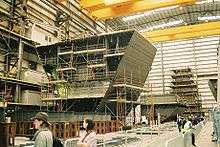
Shipbuilding recommenced on the site in 2003 following the construction of a facility by VT Group on the site of No. 13 dry dock (having relocated there from the old Thornycroft Yard in Woolston, Southampton). Modular construction of warships took place in an interlinked complex of large buildings: the Steelwork Production Hall, the Unit Construction Hall and the Ship Assembly Hall. Construction of modules for the Type 45 destroyers and Queen Elizabeth-class aircraft carriers took place here, latterly under BAE Systems Maritime – Naval Ships; but in 2013 it was announced that shipbuilding in Portsmouth would cease;[23] as of 2016 the former shipbuilding complex is being used for repairing minehunters and other small craft.[58]
BAE Systems, having subsumed Fleet Support Ltd, continues to manage ship repair and maintenance facilities around No. 3 Basin at Portsmouth.
Trafalgar 200
In the summer of 2005 Portsmouth Naval Base and the Solent played host to two special events organised as part of the Trafalgar 200 commemorations recognising the 200th Anniversary of the Battle of Trafalgar. These were the International Fleet Review and the International Festival of the Sea.
Civil and military administration of the Dockyard

From 1546 until 1832 prime responsibility for administering H.M. Royal Navy Dockyards lay with the Navy Board, and resident commissioners who were naval officers though civilian employees of the Navy Board, not sea officers [59] in charge of the day-to-day operational running of the dockyard and superintendence of its staff, following the abolition of that board its functions were merged within the Admiralty and a new post styled Admiral-superintendent was established the admiral-superintendent usually held the rank of rear-admiral though sometimes vice-admiral. His immediate subordinate was an officer known as the captain of the dockyard (or captain of the port from 1969). This followed the appointment of a (civilian) Chief Executive of the Royal Dockyards in September 1969[60] and the creation of a centralised Royal Dockyards Management Board.[61] Admiral-superintendents ceased to be appointed in the royal navy after 15 September 1971, and existing post-holders were renamed port admirals.[62] In May 1971 the post was renamed Flag Officer, Portsmouth and Admiral Superintendent until July 1971 when it was renamed Flag Officer, Spithead and Port Admiral until August 1975, the post name was changed again to Flag Officer, Portsmouth and Port Admiral until October 1996 when it ceased to exist as a separate command that was then absorbed into the First Flotilla Command later renamed Portsmouth Flotilla.
Associated establishments in the Portsmouth area
The presence of the Dockyard and Fleet led to the establishment of a variety of other naval and military installations in and around Portsmouth over the years, some of which are listed below.
Naval
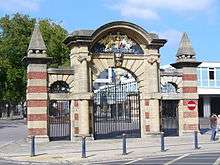
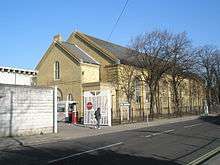
- HMS Nelson: HM Naval Base Portsmouth. Today the name encompasses the entire base, including both the dockyard and the Naval Personnel Centre on Queen Street. Previously it had signified only the latter (opened as Portsmouth Naval Barracks in 1903, later named HMS Victory after the Commander-in-Chief's flagship, renamed Nelson in 1974 to avoid confusion). The barrack blocks were mostly demolished and rebuilt in the latter half of the 20th century, but a number of other original buildings remain including the canteen, the drill shed and the Wardroom across the street. One barrack block does remain from an earlier (Army) barracks (Anglesey Barracks) which formerly stood on the site.[63] In November 2016 the Ministry of Defence published A Better Defence Estate, which indicates that the HMS Nelson Wardroom will be disposed of by 2021.[64]
- HMS Excellent: Whale Island, Portsmouth (includes Navy Command Headquarters together with a front-line Naval Training establishment operated by Babcock International (with all catering, front of house, cleaning and hotel services sub-contracted to Compass Group plc)). The name was formerly attached to the barracks and other facilities of the RN Gunnery Establishment (based on the island from 1891–1985); these now form part of the training base.[65]
- HMS Temeraire: Burnaby Road, Portsmouth. Training of Naval Physical Training Instructors and sports grounds and facilities for Portsmouth-based personnel. RN School of Physical Training has been known as Temeraire since 1971, and moved to its current site in 1988.[66]
- HMS Collingwood: Fareham. Naval training provided mainly under contract to Babcock International (catering and cleaning services are sub-contracted to Sodexo). Commissioned in 1940 as a training establishment for 'new entry' seamen, it later housed the RN School of Electrical Engineering, but serves today as headquarters of the Maritime Warfare School.[67]
- HMS Sultan: Gosport. Naval (and tri-service) training, home of the centre of excellence for mechanical and electrical engineering. Naval training provided mainly under contract to Babcock International (catering and cleaning services are sub-contracted to Sodexo); opened on this site in 1956.[68]
Decommissioned
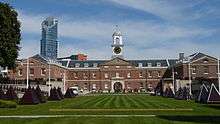
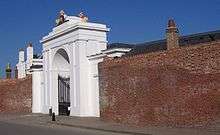
- HMS Dryad: Now MOD Southwick Park—Tri-Service Defence School of Policing and Guarding
- HMS Dolphin diesel electric submarine base—Now MOD Fort Blockhouse
- HM Gun Wharf, later HMS Vernon torpedo and mines establishment — Now in civilian use as Gunwharf Quays
- HMS Daedalus Fleet Air Arm base
- Royal Naval Hospital, Haslar
- Eastney Barracks (Royal Marine Artillery barracks 1867–1923, Royal Marines barracks 1923–1995) — converted into housing.
- Forton Barracks (Royal Marine Light Infantry barracks 1848–1923, then HMS St Vincent boys' training establishment until 1968) — Now in civilian use as St Vincent College
- Royal Clarence Victualling Yard, Gosport
- RNAD Gosport: a composite site which included:
- RNAD Priddy's Hard (1776) gunpowder storage and shell-filling facility. Closed 1988 — now Explosion! Museum of Naval Firepower
- RNAD Bedenham (1908) gunpowder stores were moved here from Priddy's Hard (judged to be dangerously close to the Dockyard).
- RNAD Elson (now part of DM Gosport)
- RNAD Frater (now part of DM Gosport)
- RNAD Marchwood (1811) closed 1961 – Converted for housing and use by Marchwood Yacht Club
- Haslar Gunboat Yard (opened 1859, closed 1973)
- HMS Mercury: RN Signals School 1941–1993, Leydene House, East Meon, near Portsmouth
- HMS Phoenix: Fire fighting training establishment 1946–1993, now part of HMS Excellent
Military
The Fortifications of Portsmouth were developed over several centuries to protect the fleet and dockyard from attacks either by land or by sea. From 1665 Bernard de Gomme oversaw construction of defensive Lines around both Portsmouth (the Dockyard and the old town) and Gosport (on the opposite side of Portsmouth Harbour). These defences were extended in the 18th century, before being superseded in the 19th by the Palmerston forts which encircle Portsmouth on and off-shore.

These fortifications required substantial numbers of personnel to man them and, from the mid-18th century onwards, they (together with other troops who were either stationed in the garrison or preparing to embark overseas) were accommodated in a variety of barracks in and around the city. By 1900 these included:
- Cambridge Barracks, High Street (Infantry) – established in 1825 in a set of late-18th century warehouses;[69] the officers' quarters have been occupied by Portsmouth Grammar School since 1926.[70]
- Clarence Barracks (Royal Garrison Artillery) – established in 1760 as Fourhouse Barracks on land between St Nicholas Street and the fortifications (alongside an earlier Royal Marine Barracks);[71] renamed in 1827; rebuilt around 1881, expanding across the old defensive lines into the field beyond; demolished c.1967.
- Colewort Barracks, St George's Road (Army Service Corps) – built as a garrison hospital, converted to barracks 1694, demolished to make way for expansion of nearby power station in the 1920s.
- Hilsea Barracks (Royal Field Artillery) – built 1854, Royal Army Ordnance Corps from 1921; closed 1962, site redeveloped for housing (the surviving 18th-century Gatcombe House served as the Officers' Mess).[72]
- Milldam Barracks (Royal Engineers) – built late 18th century onwards, housed the Engineers responsible for upkeep of the fortifications; sold in 1969 and now occupied by the University of Portsmouth[73] and Portsmouth Register Office.[74]
- Point Barracks (Artillery) – built alongside the medieval Round Tower in 1846–50; sold to Portsmouth City Council in the early 1960s following disbandment of the UK's Coastal Artillery network.[75] Part of the brick structure was demolished, but is marked by stones in the ground alongside the surviving casemates.[76]
- St George Barracks, Gosport (Infantry) – built 1856–59 as a transit barracks for troops, continuing in military use until 1991; several buildings remain, since converted to new uses.[77]
- Victoria Barracks (Infantry) – built in 1888 alongside New Clarence Barracks; demolished 1967.
According to the census over 6,000 men were living in barracks in the Portsmouth area in 1911. [78]
See also
- Portsmouth Dockyard (Tissot), 1877 painting
References
- https://webarchive.nationalarchives.gov.uk/+/http://www.royalnavy.mod.uk/operations-and-support/establishments/naval-bases-and-air-stations/hmnb-portsmouth/history/index.htm
- Mackie, Colin (20 May 2020). "Admirals Current May 2020" (PDF). gulabin.com. Colin Mackie. Retrieved 23 May 2020.
Commodore Craig Wood: Commander, Surface Flotilla, April 2020
- Coad, Jonathan (2013). Support for the Fleet: architecture and engineering of the Royal Navy's bases, 1700–1914. Swindon: English Heritage.
- "Portsmouth Dockyard becomes Fleet Maintenance & Repair Organisation". Dockyard Timeline. Portsmouth Royal Dockyard Historical Trust. Retrieved 21 February 2019.
- "1998 - F.M.R.O. taken over by Fleet Support Limited". Dockyard Timeline. Portsmouth Royal Dockyard Historical Trust. Retrieved 21 February 2019.
- "20th-century Naval Dockyards characterisation report". Historic England. Historic England. Retrieved 5 February 2017.
- "Drilling rig starts Portsmouth aircraft carriers work". BBC News. 13 February 2012.
- Portsmouth News, 6 July 2007.
- "Shipbuilding could return to Portsmouth, says BAE Systems chairman". 8 July 2014. Retrieved 14 December 2014.
- Abroad again in Britain, BBC
- Historic England. "Block Mill & Nos 35 & 36 Stores (Building No 1/153) (1078288)". National Heritage List for England. Retrieved 16 February 2019.
- "Defence Secretary announces Type 23 base port moves". royalnavy.mod.uk. 24 November 2018. Retrieved 6 December 2018.
- "HMS Forth welcomed to her home port of Portsmouth". royalnavy.mod.uk. 26 February 2018. Retrieved 6 December 2018.
- "Portsmouth Historic Dockyard website".
- "Portsmouth Royal Dockyard Historical Trust".
- "Latest Project Update". Royal Marines Museum. Retrieved 1 February 2019.
- "2016 Annual Report & Accounts, PNBPT" (PDF). Charity Commission. Retrieved 6 February 2017.
- "Portsmouth Historic Dockyard: First Prize". Latz und partner. Retrieved 6 February 2017.
- https://webarchive.nationalarchives.gov.uk/+/http://www.royalnavy.mod.uk/operations-and-support/establishments/naval-bases-and-air-stations/hmnb-portsmouth/history/index.htm
- "Portsmouth Historic Dockyard timeline".
- "Dockyard Timeline 1495-1690". Portsmouth Royal Dockyard Historical Trust. Retrieved 3 February 2019.
- "Docks 1 to 6 (Consecutive) Quay Walls and Bollards (Including North and South Camber Mast Pond and Tunnel to Same)". Retrieved 6 December 2018.
- Brown, Paul (2016). Maritime Portsmouth. Stroud, Gloucestershire: The History Press.
- "History 1690–1840". www.portsmouthdockyard.org.uk. Retrieved 7 October 2009.
- "Dockyard plan 1700". Portsmouth Royal Dockyard Historical Trust. Retrieved 12 February 2019.
- "Dockyard Wall victory Gate and Dockyard Wall". Retrieved 6 December 2018.
- Historic England. "Long Row (1715-19) (1272307)". National Heritage List for England. Retrieved 5 February 2019.
- Historic England. "Short Row (1244549)". National Heritage List for England. Retrieved 5 February 2019.
- "Former Royal Naval Academy (Buildings Numbers 1/14, 1/116-19) and Attached Railings". Retrieved 6 December 2018.
- "Portsmouth Dockyard 1774 [incorrectly captioned 1794]". getty images. Retrieved 14 February 2019.
- "Number 9 Store (Building Number 1/35)". Retrieved 6 December 2018.
- "Number 10 Store (Building Number 1/58)". Retrieved 6 December 2018.
- "Number 11 Store (Building Number 1/59)". Retrieved 6 December 2018.
- "Numbers 18 and 19 Stores with Linking and Attached Bollards (Buildings Numbers 1/65 and 75)". Retrieved 6 December 2018.
- Historic England. "Admiralty House (1784-6) (1244604)". National Heritage List for England. Retrieved 5 February 2019.
- Historic England. "Church of St Ann (1785-6) (1386817)". National Heritage List for England. Retrieved 5 February 2019.
- Historic England. "Number 25 Store (Building Number 1/118) (1244578)". National Heritage List for England. Retrieved 15 February 2019.
- Historic England. "South Office Block (Building No 1/88) (1272314)". National Heritage List for England. Retrieved 16 February 2019.
- Historic England. "Grade I listing for Docks 1–6 together with Basin, Mast Pond, etc (1272267)". National Heritage List for England. Retrieved 2 August 2015.
- Guillery, Peter. "THE BLOCK MILLS, PORTSMOUTH NAVAL DOCKYARD, HAMPSHIRE - AN ANALYSIS OF THE BUILDING". Historic England. Retrieved 16 February 2019.
- "Former School of Naval Architecture (Building Number 1/22)". Retrieved 6 December 2018.
- "School History leaflet" (PDF).
- "Listed building text: No 2 Ship Shop (1846)".
- "Brass Foundry (1848)". Retrieved 6 December 2018.
- "Iron Foundry (1857–61)". Retrieved 6 December 2018.
- "1852 - Steam Smithery opened". Portsmouth Royal Dockyard Historical Trust. Retrieved 2 February 2019.
- "No 1 Pumping Station (1878)". Retrieved 6 December 2018.
- "Dockyard timeline 1840–1914". portsmouthdockyard.org.uk. Portsmouth Royal Dockyard Historical Trust. Retrieved 6 February 2017.
- Historic England. "FORMER RAILWAY STATION AND WAITING ROOM (BUILDING NUMBER 1/47) (1272293)". National Heritage List for England. Retrieved 6 February 2017.
- Historic England. "THE ROYAL RAILWAY SHELTER (BUILDING NUMBER 1/45) (1272292)". National Heritage List for England. Retrieved 6 February 2017.
- "The Great Docks". portsmouthdockyard.org.uk. Retrieved 6 December 2018.
- "Portsmouth Dockyard timeline".
- Historic England. "Chain & Cable Test House & Store (1272294)". National Heritage List for England. Retrieved 2 February 2019.
- "Dockyard timeline".
- "Portsmouth Dockyard timeline: new semaphore tower".
- "History 1914 -1984". PORTSMOUTH ROYAL DOCKYARD HISTORICAL TRUST. Retrieved 11 February 2019.
- "Timeline: 1984–present". Portsmouth Royal Dockyard historical trust. Retrieved 7 February 2017.
- "Portsmouth's shiphall vacant no more as 'world-class' navy refit facility opened". The News. Retrieved 1 September 2016.
- Archives, The National. "Royal Naval dockyard staff – The National Archives". The National Archives. the National Archives. Retrieved 21 March 2017.
- "House of Commons 15 October 1969". Hansard.
- "House of Commons 27 July 1971". Hansard.
- "Portsmouth Royal Dockyard Historical Trust".
- Historic England. "Listing text (1387148)". National Heritage List for England. Retrieved 4 August 2015.
- "A Better Defence Estate" (PDF). GOV.UK. Ministry of Defence. 7 November 2016. p. 15.
- "RN website: history of HMS Excellent".
- "RN website: history of HMS Temeraire".
- "RN Website: HMS Collingwood".
- "RN website: history of HMS Sultan".
- Historic England. "Outbuildings to South West of Portsmouth Grammar School (1333200)". National Heritage List for England. Retrieved 17 September 2017.
- Historic England. "Portsmouth Grammar School and attached railings (1333199)". National Heritage List for England. Retrieved 17 September 2017.
- Slight, Henry. "The Military History of Portsmouth (1828)". archive.org. Retrieved 18 September 2015.
- "Hilsea Barracks". History in Portsmouth. Retrieved 4 December 2016.
- Historic England. "UNIVERSITY OF PORTSMOUTH, SCHOOL OF SOCIAL AND HISTORIC STUDIES (1386913)". National Heritage List for England. Retrieved 6 December 2018.
- Historic England. "MILL DAM HOUSE (1386911)". National Heritage List for England. Retrieved 6 December 2018.
- "Portsmouth Guide".
- "Portsmouth Museums and Records".
- Historic England. "Listing description of main barracks block (1233824)". National Heritage List for England. Retrieved 23 September 2015.
- Quail, Sarah (2014). Portsmouth in the Great War. Pen and Sword.
Bibliography
- Goss, James (1984). Portsmouth-built warships 1497–1967. Kenneth Mason.
Further reading
- Brown, Paul (2016). Maritime Portsmouth. Stroud, Gloucestershire: The History Press. ISBN 9780750965132.
- Courtney, Stephen; Patterson, Brian (2005). Home of the Fleet: a century of Portsmouth Royal Dockyard in photographs. Stroud, Gloucestershire: Royal Naval Museum. ISBN 0-7509-2285-0.
- Hamilton, C. I. (2005). Portsmouth Dockyard Papers, 1852–1869: From Wood to Steel, a calendar. Winchester.
- Johnston, Ian; Buxton, Ian (2013). The Battleship Builders – Constructing and Arming British Capital Ships. Annapolis, Maryland: Naval Institute Press. ISBN 978-1-59114-027-6.
- Knight, R.J.B. (2005). Portsmouth Dockyard Papers, 1774–1783: the American War, a calendar. Winchester.
External links
| Wikimedia Commons has media related to HMNB Portsmouth. |
- HMNB Portsmouth web page
- Portsmouth Royal Dockyard Historical Trust website
- Portsmouth Historic Dockyard website
- Portsmouth Naval Base Property Trust
- Portsmouth D-Day Museum
- Queen's Harbour Master, Portsmouth
- A Geometrical Plan, & West Elevation of His Majesty’s Dock-Yard, near Portsmouth, with Part of the Common, &c., dated 1754 (Pierre-Charles Canot after Thomas Milton and John Cleveley the Elder)